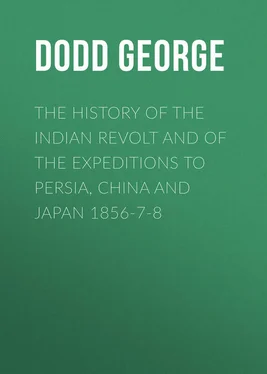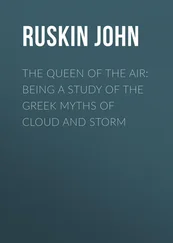George Dodd - The History of the Indian Revolt and of the Expeditions to Persia, China and Japan 1856-7-8
Здесь есть возможность читать онлайн «George Dodd - The History of the Indian Revolt and of the Expeditions to Persia, China and Japan 1856-7-8» — ознакомительный отрывок электронной книги совершенно бесплатно, а после прочтения отрывка купить полную версию. В некоторых случаях можно слушать аудио, скачать через торрент в формате fb2 и присутствует краткое содержание. Жанр: foreign_antique, foreign_prose, на английском языке. Описание произведения, (предисловие) а так же отзывы посетителей доступны на портале библиотеки ЛибКат.
- Название:The History of the Indian Revolt and of the Expeditions to Persia, China and Japan 1856-7-8
- Автор:
- Жанр:
- Год:неизвестен
- ISBN:нет данных
- Рейтинг книги:3 / 5. Голосов: 1
-
Избранное:Добавить в избранное
- Отзывы:
-
Ваша оценка:
- 60
- 1
- 2
- 3
- 4
- 5
The History of the Indian Revolt and of the Expeditions to Persia, China and Japan 1856-7-8: краткое содержание, описание и аннотация
Предлагаем к чтению аннотацию, описание, краткое содержание или предисловие (зависит от того, что написал сам автор книги «The History of the Indian Revolt and of the Expeditions to Persia, China and Japan 1856-7-8»). Если вы не нашли необходимую информацию о книге — напишите в комментариях, мы постараемся отыскать её.
The History of the Indian Revolt and of the Expeditions to Persia, China and Japan 1856-7-8 — читать онлайн ознакомительный отрывок
Ниже представлен текст книги, разбитый по страницам. Система сохранения места последней прочитанной страницы, позволяет с удобством читать онлайн бесплатно книгу «The History of the Indian Revolt and of the Expeditions to Persia, China and Japan 1856-7-8», без необходимости каждый раз заново искать на чём Вы остановились. Поставьте закладку, и сможете в любой момент перейти на страницу, на которой закончили чтение.
Интервал:
Закладка:
Leaving for future chapters a further elucidation of the relations between the European officers and the native troops – so important in connection with the Revolt – and a description of the sepoys in their dresses, usages, and personal characteristics – we shall now proceed to view the native army under two different aspects – first, when barracked and cantoned in time of peace; and, secondly, when on the march towards a scene of war.
And first, for the army when stationary. At Calcutta, Bombay, and Madras, there are solidly built barracks for the whole of the soldiery, men as well as officers; but in almost all other parts of India the arrangements are of a slighter and less permanent character. At the cantonments, it is true, the officers have houses; but the sepoys are lodged in huts of their own construction. Around the cantonments at the stations, and generally skirting the parade-grounds, are the houses or bungalows of the officers. Within the lines of the cantonment, too, the officers’ mess-rooms are situated; and at the larger stations may be seen ball-rooms, theatres, and racket-courts; while outside is a race-stand for witnessing the sports which Englishmen love in India as well as at home.
1. Subadar – major. 2. Jemadar – Lieutenant. 3. Subadar – Captain. 4. Naik – Corporal. 5. Havildar – Sergeant. 6. Sepoy – Private.
The Indian bungalows, the houses inhabited by European officers at the different towns and stations in India, have a certain general resemblance, although differing of course much in details. A bungalow of good size has usually a central room called the hall, a smaller room opening on the front verandah, a similar one opening on the back verandah, three narrower rooms on each side of these three, and bathing-rooms at the four corners. A verandah runs entirely round the exterior. The central hall has only the borrowed light derived from eight or a dozen doors leading out of the surrounding apartments: these doors are always open; but the doorways are covered, when privacy is desired, with the chick , a sort of gauze-work of green-painted strips of fine bamboo, admitting air and light, but keeping out flies and mosquitoes. The floors are usually of chunam , finely tempered clay, covered with matting, and then with a sort of blue-striped carpet or with printed calico. The exterior is usually barn-like and ugly, with its huge roof, tiled or thatched, sloping down to the pillars of the verandah. Air and shade are the two desiderata in every bungalow, and adornment is wisely sacrificed to these. The finest part of the whole is the surrounding space or garden, called the compound , from a Portuguese word. The larger the space allowed for this compound, the more pleasant is the residence in its centre, and the more agreeable to the eye is a cantonment of such bungalows. The trees and fruits in these enclosures are delicious to the sight, and most welcome to the heat-wearied occupants of the dwellings. Officers in the Company’s service, whether military or civil, live much under canvas during the hot seasons, at some of the stations; and the tents they use are much larger and more like regular habitations than those known in Europe. The tents are double, having a space of half a yard or so between the two canvas walls, to temper the heat of the sun. The double-poled tents are large enough to contain several apartments, and are furnished with glass-doors to fit into the openings. A wall of canvas separates the outer offices and bathing-rooms. Gay chintz for wall-linings, and printed cotton carpets, give a degree of smartness to the interior. Movable stoves, or else fire-dishes for wood-fuel called chillumchees , are provided as a resource against the chill that often pervades the air in the evening of a hot day. The tents for the common soldiers hold ten men each with great ease, and have a double canvas wall like the others.
An important part of every cantonment is the bazaar, situated in convenient proximity to the huts or tents of the troops. It comprises an enormous number of sutlers, who sell to the soldiers those commodities which cannot well be dispensed with, but which cannot conveniently be provided and carried about by them. Curry stuffs, tobacco, rice, arrack (in addition to the Company’s allowance), cotton cloth, and a multiplicity of other articles, are sold at these bazaars; and the market-people who supply these things, with their families, the coolies or porters, and their hackeries or carts – add enormously to the mass that constitutes an Indian cantonment. The sepoy has little to spend with his sixpence a day; but then his wants are few; and his copper pice , somewhat larger than the English farthing, will buy an amount of necessaries little dreamed of in England. The Hindoos have such peculiar notions connected with food and cooking, that the government leave them as much to themselves as possible in those matters; and the bazaar and sutlers’ arrangements assume a particular importance from this circumstance.
An Anglo-Indian army we have seen at rest, in cantonments. Now let us trace it when on a march to a scene of war; but while describing this in the present tense, we must make allowance for the changes which the Revolt has inevitably produced.
The non-fighting men who accompany the troops greatly exceed in number the troops themselves. Captain Munro says: ‘It would be absurd for a captain to think of taking the field without being attended by the following enormous retinue – namely, a dubash (agent or commissionaire), a cook, and a maty boy (servant-of-all-work); if he cannot get bullocks, he must assemble fifteen or twenty coolies to carry his baggage, together with a horse-keeper and grass-cutter, and sometimes a dulcinea and her train, having occasionally the assistance of a barber, a washer, and an ironer, in common with the other officers of his regiment. His tent is furnished with a good large bed, mattress, pillows, &c., a few camp stools or chairs, a folding table, a pair of glass shades for his candles, six or seven trunks, with table equipage, his stock of linens (at least twenty-four suits), some dozens of wine, porter, brandy, and gin; with tea, sugar, and biscuit, a hamper of live poultry, and his milch-goat. A private’s tent for holding his servants and the overplus of his baggage is also requisite; but this is not at the Company’s expense.’ Of course it must be inferred that all this luxury belongs to the best of times only, and is not available in the exigency of sudden military movements. The sepoys or common soldiers, too, have their satellites. Each man is accompanied by his whole family, who live upon his pay and allowances of rice from the Company. Every trooper or horse-soldier, too, has his grass-cutter; for it is a day’s work for one person to dig, cut, and prepare a day’s grass for one horse.
When on the march, the tents are generally struck soon after midnight. At the first tap of the drum, the servants knock up the tent-pins, and down fall the tents; horses begin to neigh and the camels to cry, the elephants and camels receive their loads of camp-equipage, the bullocks are laden with the officers’ tents and boxes, the coolies take up their burdens, and all prepare for the road. During the noise and bustle of these preliminaries, the officers and men make their few personal arrangements, aided by their servants or families; while the officers’ cooks and agents are sent on in advance, to prepare breakfast at the next halting-place. Between one and two o’clock the regiments start off, in columns of sections: the camp-followers, baggage, bullocks, elephants, and camels, bringing up the rear. The European soldiers do not carry their own knapsacks on the march; they have the luxury of cook-boys or attendants, who render this service for them. The natives, it is found, are able to carry heavier loads than the Europeans; or – what is perhaps more nearly the case – they bear the burdens more patiently, as the Europeans love soldiering better than portering. The tedium of the journey is sometimes relieved by a hunt after antelopes, hares, partridges, wild ducks, or wild boars, which the officers may happen to espy, according to the nature of the country through which they are passing. Arrived at the halting-place, everything is quickly prepared for a rest and a breakfast; the quarter-masters push forward to occupy the ground; the elephants and camels are disburdened of the tents; the natives and the cattle plunge into some neighbouring pool or tank to refresh themselves; the cooks have been already some time at work; and the officers sit down to a breakfast of tea, coffee, curry, rice, pillau, ham, and other obtainable dishes. The fakeers often recognise their friends or admirers among the natives of the cavalcade, and give loud blessings, and tom-tom drummings, in exchange for donations of the smallest Indian coins. The quarter-masters’ arrangements are so quickly and so neatly made, that in a short time the general’s durbar appears in the centre of a street of tents for staff-officers, dining-tents on the one side and sleeping-tents on the other; while the bazaar-dealers open their temporary shops in the rear. The horses are picketed in long lines; while the elephants and camels browse or rest at leisure. Under ordinary circumstances, the day’s marching is over by nine o’clock in the morning, at which hour the sun’s heat becomes too fierce to be willingly borne. Repose, amusements, and light camp-duties fill up the remainder of the day, to be followed by a like routine on the morrow.
Читать дальшеИнтервал:
Закладка:
Похожие книги на «The History of the Indian Revolt and of the Expeditions to Persia, China and Japan 1856-7-8»
Представляем Вашему вниманию похожие книги на «The History of the Indian Revolt and of the Expeditions to Persia, China and Japan 1856-7-8» списком для выбора. Мы отобрали схожую по названию и смыслу литературу в надежде предоставить читателям больше вариантов отыскать новые, интересные, ещё непрочитанные произведения.
Обсуждение, отзывы о книге «The History of the Indian Revolt and of the Expeditions to Persia, China and Japan 1856-7-8» и просто собственные мнения читателей. Оставьте ваши комментарии, напишите, что Вы думаете о произведении, его смысле или главных героях. Укажите что конкретно понравилось, а что нет, и почему Вы так считаете.












